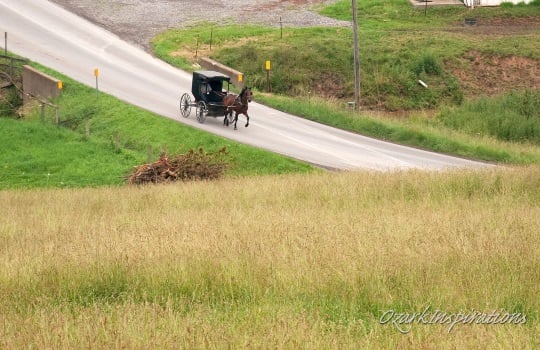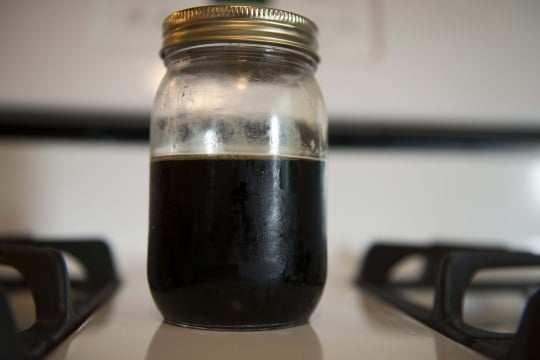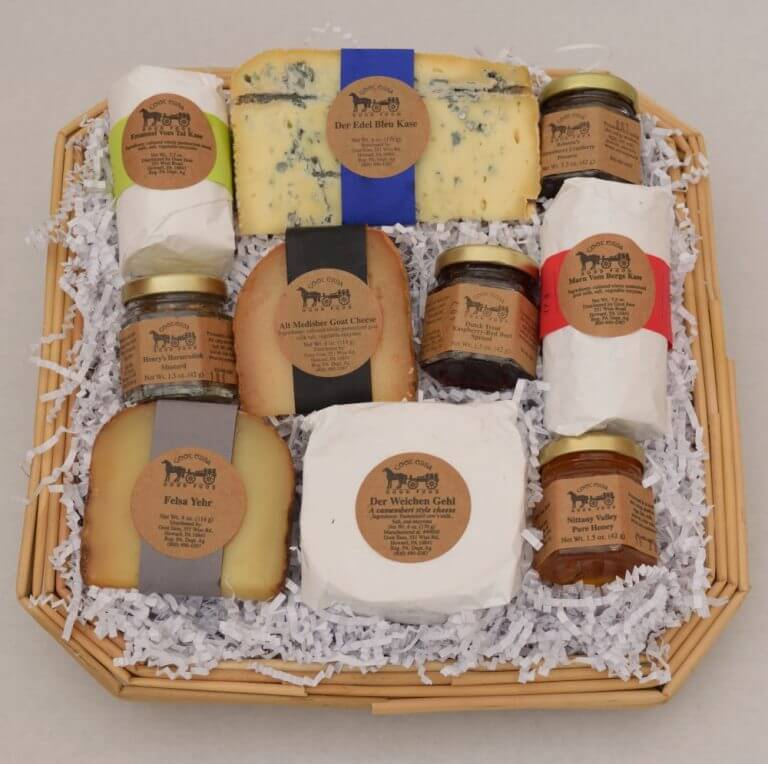Morning Milk
When I stay at John and Rachel’s* home in Lancaster County, one of my morning tasks is to go on a milk run. This doesn’t mean running down to the store but rather to the closest source possible. And in this part of the world, that means another Amish farm. Here’s the jar I used one morning:

Not “Strawberry Jelly” but organic cow milk in that jar, enough for a family of nine (and one guest).
So most mornings, the smell of something nice cooking is beginning to fill the home as I stumble downstairs around 6 or 630 AM (depending on when that day’s breakfast hour is, agreed upon the night before…this is not a dairy family with a rigid wake-up time).
You never know what Rachel’s got in mind for breakfast but usually includes any of: overeasy eggs, scrambled eggs, waffles, toast, bacon, pancakes, sausage gravy, shoofly pie or cake, and assorted condiments and beverages (milk, coffee, homemade ketchup, water, smoothie, powder seasoning, maybe some kombucha).
Breakfast here, by the way, is typically a scramble to grab what you can, as this home consists of six boys and one girl, and most of them are old enough to scrap hard for their share. Reminds me of how my dad, also one of seven, used to describe his meal tables.
And if you’ve eaten at an Amish table before, you know that there are not a lot of niceties, at least not compared to the rest of over-polite America. If you want eggs, you say in a definitive tone, “eggs”, ditto ketchup or whatever it might be.
But back to the milk-getting.
Dating back to the earliest days of my staying at John and Rachel’s, I would regularly joke that I would go swipe milk from the next-door-neighbor farmer. The next door neighbor…was actually my friend’s dad and “next door” was technically the other half of a single 200-year-old farmhouse which could be transformed into a continuous abode simply by opening the parlor doors (which is what they do when hosting youth singings or other large groups).
Later they moved to the house just down the lane. So I would go procure milk then from John’s brother. A bit longer walk but not by much. The routine was the same. Go into the milkhouse with the somethinghundred-gallon stainless steel bulk milk tank, unscrew the cap at the bottom, position the jar or pitcher I had gotten from Rachel, and move the lever just a bit until a pressurized stream of raw organic milk would come shooting out. Fill, rinse the outlet off with the hose, cap it and go. Oh and be sure to say hi or bye to whoever’s finishing up the morning milking tasks on your way out or in.
On my latest visit I stopped once at John’s brother for milk, and then the next, Rachel suggested we could try at a neighbor’s farm. John’s 12-year-old-son Eli was along with me. As we were pulling in, Eli mentions this farmer also has sheep’s milk, with what might be a hint of a mischievous tone. Eehhh…let’s keep it cow today, alright?

The purveyor of the establishment happened to be in the milkhouse as we entered. I had met him, a fifty-something farmer (maybe sixty-something by now) on several occasions dating back years. I’m not sure if he recognized me but he did recognize Eli. We got our milk and headed out to return in time for breakfast. No cash is transacted on the spot. I assume someone makes a note of it (either the milk-drinker or the milk-owner or perhaps both), worked out efficiently and cleanly in the Amish communication ecosystem, though I’ve never bothered to ask exactly how.
Milk is one of my favorite drinks and has been so since childhood. The milk from these farms is fresh, ice-cold and delicious. Thankfully I have til now avoided contracting adult-onset lactose intolerance or a dairy allergy or anything like that, and God willing I don’t plan to. Would hate to have to give up die Millich.
Fetching the morning milk is just a little task I’ve been doing for the decade-plus I’ve been visiting this Amish corner of Lancaster County, a bit of doing that lets me feel semi-useful as the real toil of running an Amish farm and household goes on around me. But it’s one that’s accompanied a lot of treasured morning memories.
Amish Milk in the News
Speaking of milk, Amish farmers in Wisconsin are having a tough time of it. Rick Barrett reports in the Milwaukee Journal Sentinel that about a dozen Amish farmers in the Monroe, WI area have been dumped by their milk buyer. This is against the backdrop of a milk market which has brought farmers depressed prices for years and has led to many dairies going out of business.
“Unfortunately, the Cooperative does not accept Grade B or Amish dairy farm milk into their milk supply”…“You will need to secure a new market on or before [Jan 1]” was the message in the letter which farmers got last month.
I spoke with Rick a couple weeks ago about why farming is important to the Amish, among other topics. The angle here is that it might be a discrimination case. To me it seems like an own-goal by the co-op who dumped them (seems they could have gotten by leaving out the “Amish” language and just stuck with the no-Grade-B-milk-anymore stipulation). However this is the Amish, and legal action initiated by Amish is highly unlikely.

In any case, there may be an alternative buyer, a nearby cheese plant, to come to the rescue. Interestingly, there’s at least one state organization to help the farmers, with a spokesman stating they are available to help them “find new markets”.
And in the “alternative milk” category, camel milk has gotten a foothold in the US, and looks to be growing. Thanks to reader Ed we’ve seen the camels of Lancaster County here more than once (they’re owned by an Amish camel milk operation, which I hear is still in business). Several weeks ago came a CNN story about a Saudi entrepreneur who has teamed with Amish in Missouri to produce the milk. At $18 a pint, the price is comparatively stratospheric.
I’ll continue to stick with cow…but I won’t turn down a glass of camel if I come across it. I’ll usually try most things at least once, if I can get a promise it won’t kill me.
*Not their real names












Wonderful word picture...
What a wonderful word picture…I was able to spend some time on a dairy farm when I was a youngster. Thanks for triggering some memories of my own experiences–while not with the Amish, there’s a commonality to farm life that is comforting.
Thanks Walter! Glad if it brought back some good memories. I enjoyed writing this one and recollecting… I am not a farm person by nature but I think spending time on a farm for at least a bit can be a valuable experience for anyone. Feel fortunate that I’ve been able to.
Family farm
That’s called up a lot of lovely memories of visits to my aunt & uncle in Kansas. They rose before the roosters to start chores. First, of course, was the milking. We were too young to do any of that but we helped by bottle feeding the calves. But for the grain products meals at their place were generally made up of things they had grown or produced on the farm and a glass of that fresh milk sat at every plate. My aunt was very proud when they got indoor plumbing…the water came to the sink but you still had to haul the ‘gray’ water out to the garden in a five gallon bucket.
Morning Milk
When I was growing up we got our milk from a neighboring farm. Usually my brother would walk over with a wide mouth gallon jar, go to the house and pay 50 cents, then go to the spring house and dip milk from a 5 gallon milk can. This was our routine for almost 15 years, we got milk 3 times a week for a family of 4. There is nothing better than raw milk.
Great AM routine Ruth. There really is a taste difference, especially compared to store-bought 2%. Thanks for sharing with us.
Don't Forget the Wisconsin Raw Milk Trials
I just wonder if this is the milk buyer’s way of sticking it to the Amish dairy farms because of Wisconsin’s raw milk controversy 7 years ago. It seems ridiculous but I wouldn’t be surprised. Their best bet is to either form a dairy co-op or food club and solicit buyers.
Do you mean the trial of Vernon Hershberger in 2013? He was called Amish in some media but nothing about his appearance suggests that he actually was Old Order Amish at that time: https://modernfarmer.com/2013/05/4-questions-raised-by-the-amish-raw-milk-trial/
Give his name he probably has Amish roots, maybe he belonged to a related Anabaptist church.
That brought back some memories
Many moons ago we rented a house on an Amish dairy farm. I would put one of those jugs (like you got your milk in) and set it on the porch of the farmer’s house when ever we needed milk. They would fill it and set it back on our porch, filled with that delicious raw milk. I kept track of our purchases by making a note on the calendar. I would pay once a month. We usually consumed about 2 gallons or more a week. The farmer’s wife also made homemade butter. It was pure yellow. I personally didn’t care for it, but my DH and son loved it. After we moved away from there, after 10 years, it took us a while to get used to drinking pasteurized milk again. There was an unused smoke house attached to our house. We had a telephone extension put in there for the farmer and his wife. They paid for the extension and kept track of their calls. Sometimes we had to pay for our milk and butter. Other times they had to pay for the phone calls. It all worked out just fine. We also didn’t have a cow when I was growing up. Amish and no cow? So one of us would run down to my uncle’s farm, down the hill, and bring back a gallon of milk. We had a galvanized milk jug that held a a gallon. Mother wrote it on the calendar. 🙂
Great memories Lydia. Everybody just keeps track of what they use and then settle up regularly. Informal and based on trust between neighbors. Nice to have that fresh milk supply nearby!
Morning milk
In upstate New York (Mohawk Valley) some Amish farmers have been told the plant will only accept organic milk in 2019. Yet the general public still wonders why there are fewer and fewer farms!
I suppose that decision is economically driven…perhaps it will work out to their benefit long-term if more Amish go organic, especially with how long the market slump has lasted. They can also get by with fewer cows which might suit some farms better.
Interesting story
I found the story very interesting, I hope to one day be able to visit Amish country next year, likely in Ohio though. It is sad to hear about the farmers who lost their market. Organic is the way to go though. People will definitely pay extra for that!
I hope you get a chance to visit Virgadean. Holmes County is a great community if you get a chance.
Yes it’s a sad thing in general reading about dairy farmers’ struggles, and not just the Amish. I thought the quote from this article really brought it home…farming is not just “another job” and it takes a pretty big emotional toll on farmers when they go through extended hard times:
https://www.timesunion.com/news/article/Dairy-farmers-struggle-with-price-slump-12904574.php
“If your average worker loses their job, it is a traumatic and stressful event. If a farmer loses their farm, they have lost their job (and) often the jobs of several family members,” he said. “They’ve lost their house, often the house they grew up in that has been in the family for generations. They have lost their land and their legacy, their history, their retirement, and what they hoped to pass on to their kids when they were gone. And last but not least, they have lost their identity. Now they are no longer a farmer. For many, that is the hardest thing to come to terms with.”
Ironically...
Just happens that I am in Lancaster County for a few days… just today heard of an Amish Dairy Farm that has switched to organic milk because they are “paid a little bit more” per 100 lbs. I am uncertain but suspect the regulations are different from state to state as to what is required for the label “organic,” but it would seem like a logical transition an Amish Farm. (Although conversely, I’ve also heard stories about Amish farmers increasing their use of pesticides and chemicals.) The farm I heard about today runs about 40 head.
As I recall, back in the ’40s and early ’50s, the “rule” was “twelve cows and you’re in clover”–meaning you could make money at that level. I’m sure that number is much higher today. Most of the small farms in Maine are holding on by selling value-added products and I suppose “organic” falls into that category. But organic milk (particularly bought from the farm) retails at nearly twice the price of milk in a grocery store so it does remain a limited opportunity.
Enjoy your visit Walter! I think that checks out. A friend’s organic farm is about 40 head and he is doing alright (though in a less-competitive, lower land-price community). Another friend, conventional farmer in Lancaster County milks around 60 normally.
Amish Dairy Farms
Erik, thank you very much for this excellent article. Do you have any tips for me on visiting an Amish dairy farm in Reno County, Kansas? Do you have a database in order o make a recommendation to me? In general, do you think the Amish would be open to an English person visiting? Thanks, Jim
Visiting Amish in Kansas
Jim, glad you liked it, thanks. Depending on what you want to do I don’t think it would be a problem, usually I just recommend visiting the area and approaching an Amish business or in this case farm – many of them sell things direct to the public (eggs, crafts, produce etc.) which is an easy way to go and meet someone. Yoder in Reno County is progressive technologically and I am going to guess they would be pretty approachable. Another Reno Co. community is at Hutchinson.
Here’s more on Kansas, we also have at least 1 or 2 posts on Amish in the state if you search in the top bar: https://amishamerica.com/kansas-amish/
I don’t have direct contacts but if you show up it usually works fine, I have almost never phoned ahead or arranged meetings with Amish people in advance, farmers, business owners etc. are used to people showing up in person. Are you just interested in visiting or want to do something more than that regarding the farm?
Organic Milk
Erik, Changing the name from raw milk to organic milk does not change the fact that it is still not homogenized, pasteurized and all the nutrients cooked out of it to meet USDA standards. Isn’t this the same milk that we are told will kill us if we drink it? The same milk that a large segment of American’s want but are not allowed to purchase? The same milk that the Amish are not allowed to provide for any one, or at least anyone that the authorities know about, like you. The same milk that farmers put on their fields in Wisconsin some years ago and the State went ape over it because it was not homogenized, pasteurized and all the nutrients cooked out of it and therefore declared anything grown on the ground was going be full of all kinds of evil diseases. Never mind all the deadly chemicals that are used on millions of acres of farm land. Ok, I am being a little sarcastic here. I grew up on ‘organic’ milk. Still get it from the Amish whenever I can. It is quit a drive for us to go after. Although they are not allowed to sell it, all donations are accepted. Just do not let the food police know about how organic milk is distributed in some places.
Just to clarify...
Here in Maine, we have been struggling (and winning a few battles) with “food sovereignty” issues such as selling raw milk directly to consumers… so I’m a little familiar with some of the milk vocabulary. Raw milk is not the opposite of organic milk. You could have raw organic milk and raw non-organic milk. (One of the challenges is defining what qualifies as “organic,” but in general it means no pesticides or chemicals are used in the process of raising.) Raw milk is “uncoooked” (meaning not pasteurized). If organic raw milk is pasteurized, it could still be considered organic. Raw milk (both organic and non-organic) is legally available on a limited basis here in Maine, from small farms who sell directly to local consumers.
Morning Milk
Thanks for the clarification. Maine must be an excepetion. Around here any milk that is not homogenized, pasteurized and all the nutrients cooked out of it can not be sold. Hopefully there are more exceptions that I do not know about. Of course there are those of us, like me, that are rebels and could care less what the USDA so-called guidelines are. PS. I find it interesting that my computer gives me a warning sign and a “Not Secure” message for this site.